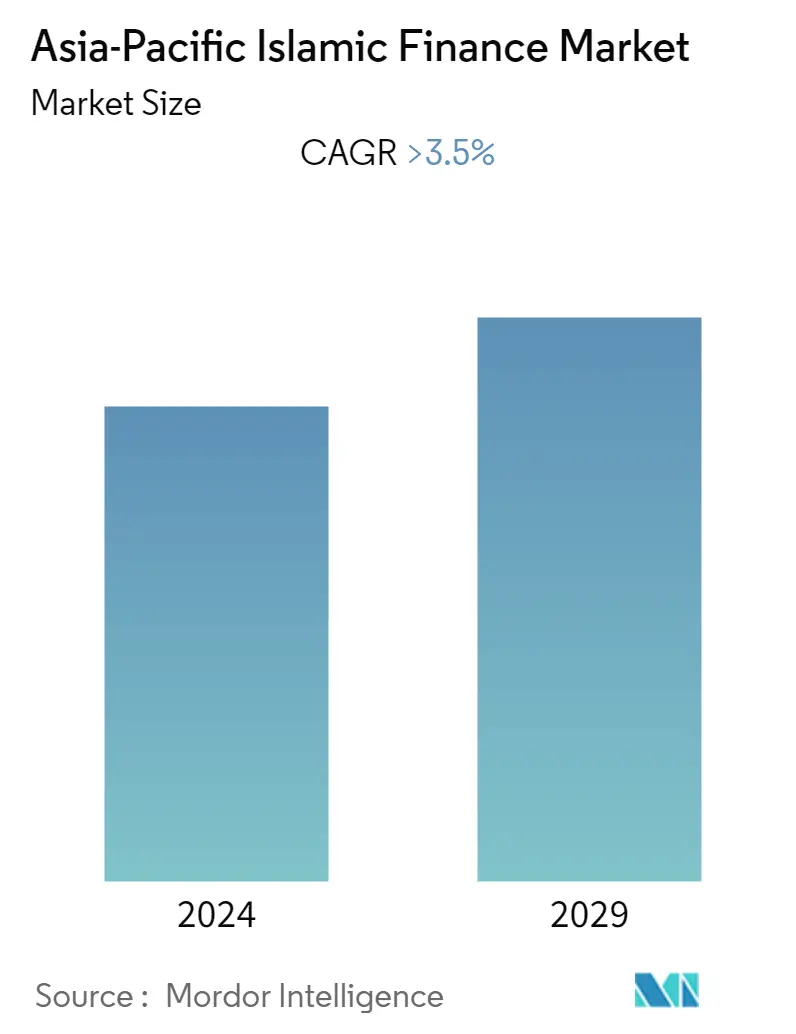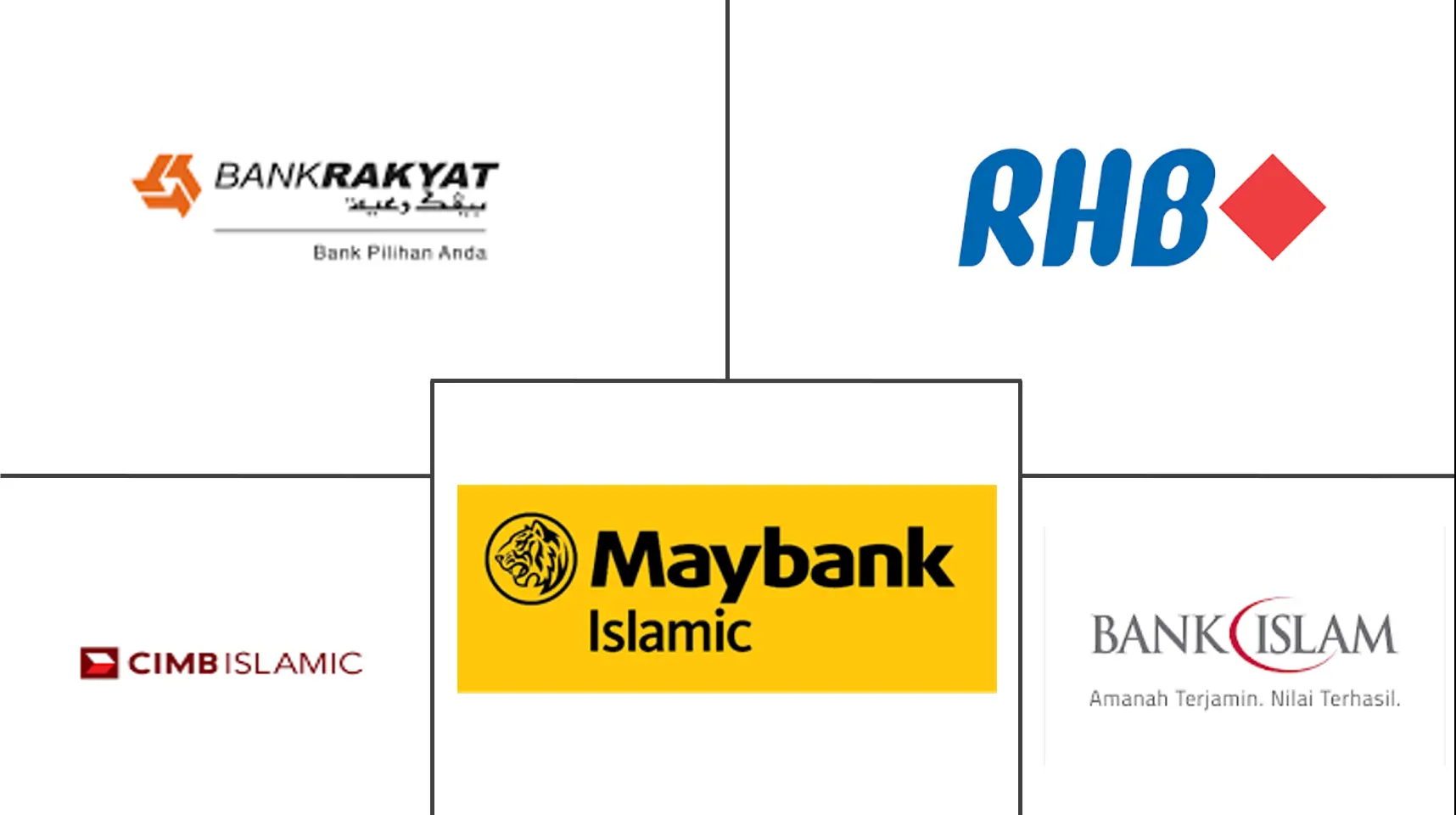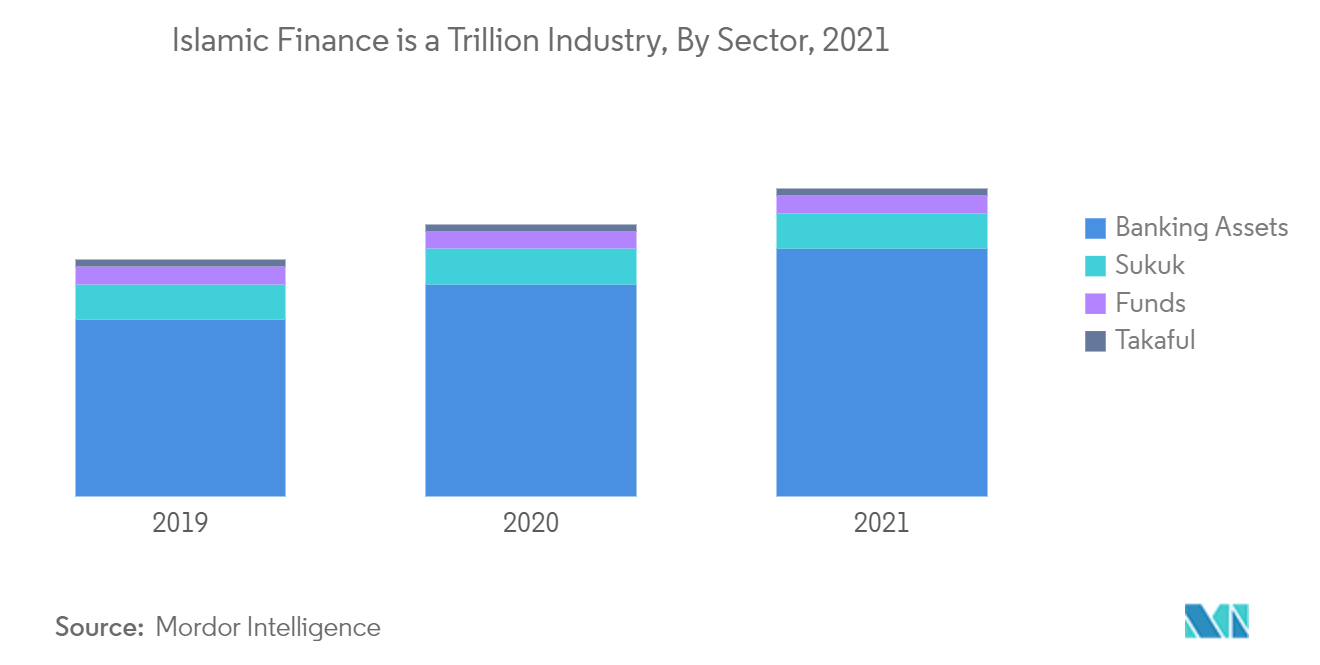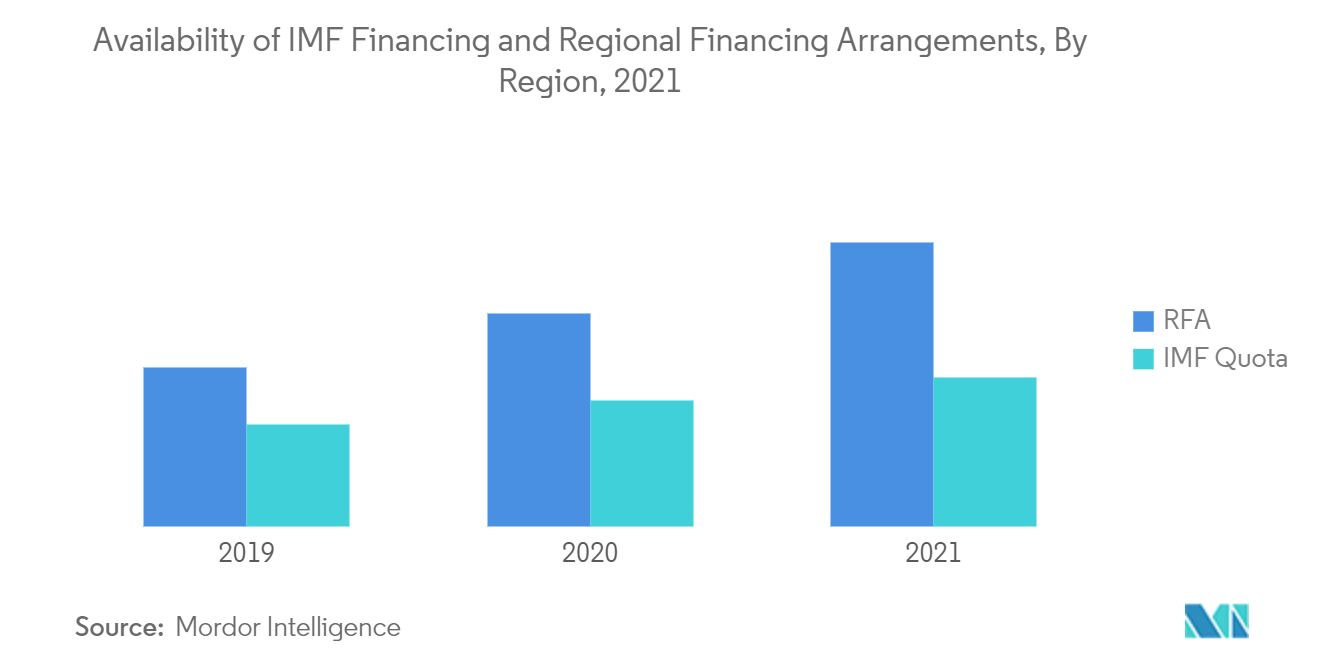APAC Islamic Finance Market Size

| Study Period | 2019 - 2028 |
| Base Year For Estimation | 2021 |
| Forecast Data Period | 2024 - 2028 |
| Historical Data Period | 2019 - 2020 |
| CAGR | > 3.50 % |
| Market Concentration | Medium |
Major Players
*Disclaimer: Major Players sorted in no particular order |
Need a report that reflects how COVID-19 has impacted this market and its growth?
APAC Islamic Finance Market Analysis
The COVID-19 pandemic has provided another opportunity for Islamic finance to prove its potential and shine. The Islamic financial system is based on the principles of risk-sharing, ethics and morality, which equip it to act as a potential warrior to safeguard the interest of the poor and vulnerable under crisis.
The Islamic finance industry has grown substantially in Asia over the last two decades. The Muslim population in different Asian countries, especially in Southeast Asia, is increasing. Rapid Muslim population growth and improving living standards may enhance the popularity of Islamic finance as a keen alternative to conventional financing mechanisms. In addition, investors from the Middle East and Asia are increasingly seeking to invest in products that are in line with their religious beliefs.
In Asia, the strong growth of Islamic finance is led by Bangladesh, Brunei Darussalam, Indonesia, Malaysia, and Pakistan. Azerbaijan, Hong Kong, China, Kazakhstan, Singapore and Thailand also have a growing niche in the Islamic finance sector. Around 65% of the global Muslim population resides in Asia, with Indonesia as the most populous Islamic country in the world. This can further drive the growth of Islamic finance products and services in the region.
APAC Islamic Finance Market Trends
This section covers the major market trends shaping the APAC Islamic Finance Market according to our research experts:
Islamic Finance is Fastest Growing Segment
The industry’s continuous expansion resulted in Islamic finance reaching systemic significance in a number of countries in Asia, including Brunei, Bangladesh, and Malaysia; these are countries where Islamic finance has achieved at least 15% market share in the domestic banking sector. Countries that do not have a predominantly Muslim population are also beginning to open their doors to Islamic finance. Luxembourg, Hong Kong, China, United Kingdom and South Africa have debuted sovereign sukuks (Islamic trust certificates, similar to conventional bonds), with all issuances being at least twice oversubscribed, demonstrating a strong demand for SCF globally.
Significantly, ADB has 14 member countries that have a majority Muslim population and has 5 of the 10 countries with the biggest Muslim population globally. Asia requires infrastructure investments of an estimate of $747 billion a year to sustain its growth trajectory. Given the demographic composition of its member countries and realizing the region’s vast investment needs, ADB recognizes the potential role of Islamic finance in promoting inclusive growth and achieving sustainable development in the region, through funding infrastructure and green and ethical investments.

ADB Supports Financial Stability
ADB recognizes the potential role of the Islamic financial sector in supporting ADB’s agenda of achieving inclusive growth, sustainable development and financial stability within the region. Islamic finance provides financial services for all segments of the population and can help increase financial inclusion. Islamic finance also serves as an alternative source for funding infrastructure and as a means of diversifying funding and risk exposures of investors.
Supporting the development of international best practices in prudential standards and corporate governance for Islamic Financial Institutions through technical assistance programs, participating in high level committees developing international standards including the Core Principles for Islamic Finance Regulation Working Group, and assisting DMCs, through program loans and technical assistance, to strengthen their legal, regulatory and institutional frameworks to enable securities market operations, bolster the capacity of their regulatory authorities and improve governance and self-regulation of stock exchanges.

APAC Islamic Finance Industry Overview
The report covers major international players operating in the Asia-Pacific Islamic Finance Market. In terms of market share, some of the major players currently dominate the market. However, with technological advancement and product innovation, mid-size to smaller companies are increasing their market presence by securing new contracts and by tapping new markets. Maybank Islamic, Bank Rakyat, CIMB Islamic Bank, RHB Islamic Bank, Bank Islam Malaysia, Public Islamic Bank, AmBank Islamic and MBSB Bank are a few of the major market players.
APAC Islamic Finance Market Leaders
Maybank Islamic
Bank Rakyat
CIMB Islamic Bank
RHB Islamic Bank
Bank Islam Malaysia
*Disclaimer: Major Players sorted in no particular order
.webp)
APAC Islamic Finance Market News
- Jan 2022: Al Rajhi Bank Malaysia (ARBM), a wholly-owned subsidiary of the world’s largest Islamic bank by assets, Al Rajhi Bank of the Kingdom of Saudi Arabia (KSA), has selected Thought Machine, the cloud native core banking technology firm, to power their upcoming next-generation digital bank and strengthen their position as a leader in Islamic banking.
- Oct 2021: Asia Digital Bank (ADB) with Bianjie’s support plans to build new digital financial infrastructure that supports seamless integration of centralized and decentralized financial services.
APAC Islamic Finance Market Report - Table of Contents
1. INTRODUCTION
1.1 Study Deliverables
1.2 Study Assumptions
1.3 Scope of the Study
2. RESEARCH METHODOLOGY
3. EXECUTIVE SUMMARY
4. MARKET DYNAMICS
4.1 Market Overview
4.2 Market Drivers
4.3 Market Restraints
4.4 Porters 5 Force Analysis
4.4.1 Threat of New Entrants
4.4.2 Bargaining Power of Buyers/Consumers
4.4.3 Bargaining Power of Suppliers
4.4.4 Threat of Substitute Products
4.4.5 Intensity of Competitive Rivalry
4.5 Impact of COVID-19 on Industry
5. MARKET SEGMENTATION
5.1 By Financial Sector
5.1.1 Islamic Banking
5.1.2 Islamic Insurance 'Takaful'
5.1.3 Islamic Bonds 'Sukuk'
5.1.4 Other Financial Institutions (OIFL's) and Islamic Funds
5.2 By Geography
5.2.1 China
5.2.2 India
5.2.3 Japan
5.2.4 Australia
5.2.5 Malaysia
5.2.6 Vietnam
5.2.7 Rest of Asia-Pacific
6. COMPETITIVE LANDSCAPE
6.1 Market Concentration Overview
6.2 Company Profiles
6.2.1 Maybank Islamic
6.2.2 Bank Rakyat
6.2.3 CIMB Islamic Bank
6.2.4 RHB Islamic Bank
6.2.5 Bank Islam Malaysia
6.2.6 Public Islamic Bank
6.2.7 AmBank Islamic
6.2.8 MBSB Bank
6.2.9 Hong Leong Islamic Bank
6.2.10 Meezan Bank
6.2.11 AFFIN Islamic Bank
6.2.12 Bank Muamalat Malaysia
6.2.13 HSBC Amanah Malaysia
6.2.14 OCBC Al-Amin Bank
6.2.15 Kuwait Finance House (Malaysia)*
- *List Not Exhaustive
7. MARKET OPPORTUNITIES AND FUTURE TRENDS
8. DISCLAIMER
APAC Islamic Finance Industry Segmentation
Islamic banking, Islamic finance, or Sharia-compliant finance is banking or financing activity that complies with Sharia and its practical application through the development of Islamic economics. Some of the modes of Islamic banking/finance include Mudarabah, Wadiah, Musharaka, Murabahah, and Ijara.
A complete background analysis of the Asia-Pacific Islamic Finance Market, which includes an assessment of the National accounts, economy, and emerging market trends by segments, significant changes in the market dynamics, and the market overview is covered in the report.
The Asia-Pacific Islamic Finance market can be segmented By Financial Sector (Islamic Banking, Islamic Insurance ‘Takaful’, Islamic Bonds ‘Sukuk’, Other Islamic Financial Institutions (OIFL’s), and Islamic Funds), By Geography (China, India, Japan, Australia, Malaysia, Vietnam, and Rest of Asia-Pacific).
| By Financial Sector | |
| Islamic Banking | |
| Islamic Insurance 'Takaful' | |
| Islamic Bonds 'Sukuk' | |
| Other Financial Institutions (OIFL's) and Islamic Funds |
| By Geography | |
| China | |
| India | |
| Japan | |
| Australia | |
| Malaysia | |
| Vietnam | |
| Rest of Asia-Pacific |
APAC Islamic Finance Market Research FAQs
What is the current Asia-Pacific Islamic Finance Market size?
The Asia-Pacific Islamic Finance Market is projected to register a CAGR of greater than 3.5% during the forecast period (2023-2028).
Who are the key players in Asia-Pacific Islamic Finance Market?
Maybank Islamic, Bank Rakyat, CIMB Islamic Bank, RHB Islamic Bank and Bank Islam Malaysia are the major companies operating in the Asia-Pacific Islamic Finance Market.
Asia-Pacific Islamic Finance Industry Report
Statistics for the 2023 Asia-Pacific Islamic Finance market share, size and revenue growth rate, created by Mordor Intelligence™ Industry Reports. Asia-Pacific Islamic Finance analysis includes a market forecast outlook to 2028 and historical overview. Get a sample of this industry analysis as a free report PDF download.
